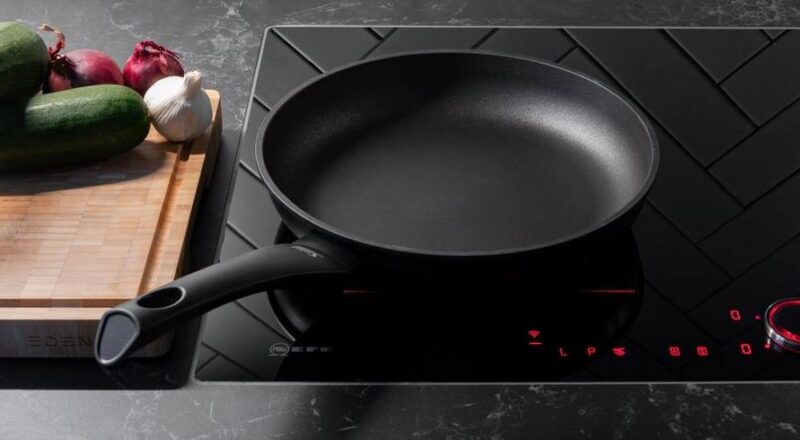Cast iron cookware has been a staple in kitchens worldwide for centuries. Its durability, heat retention, and versatility make it a favorite among professional chefs and home cooks alike. However, with the rise of induction cooking, many are left wondering about the suitability of their trusty cast iron pans. Specifically, the debate of thick vs thin cast iron for induction has emerged as a hot topic. In this article, we’ll delve into the intricacies of both to help you make an informed decision.

Understanding Induction Cooking
Induction cooking uses electromagnetic fields to heat cookware directly. This method is highly efficient and offers rapid temperature changes, making it a favorite for those who value precision in cooking. However, not all cookware is suitable for induction. It requires a magnetic base, which is why cast iron pans, known for their magnetic properties, are often recommended.
Thick Cast Iron: Pros and Cons
Pros of Thick Cast Iron
Thick cast iron pans are known for their excellent heat retention. Once heated, they maintain a consistent temperature, making them ideal for slow cooking, braising, and frying. Their weight also adds to their stability on the stovetop.
Cons of Thick Cast Iron
The primary disadvantage of thick cast iron is its weight. It can be cumbersome to handle, especially when full. Additionally, it takes longer to heat up, which might not be ideal for quick cooking methods.
Thin Cast Iron: Pros and Cons
Pros of Thin Cast Iron
Thin cast iron pans are lighter and easier to maneuver. They heat up faster, making them suitable for quick cooking techniques. Their lighter weight makes them more user-friendly, especially for those who might struggle with heavier cookware.
Cons of Thin Cast Iron
The downside of thin cast iron is its reduced heat retention compared to thicker pans. They can also be more prone to hot spots, leading to uneven cooking. For more about this, check out this guide on uneven browning.
Heat Distribution and Retention
When it comes to heat distribution and retention, thick cast iron pans typically outperform their thinner counterparts. Their superior heat retention makes them perfect for recipes requiring steady, even heat over prolonged periods.
Durability and Longevity
Both thick and thin cast iron pans are known for their durability. However, thick cast iron pans are generally more resistant to warping, making them a long-term investment.
Performance on Induction Cooktops
Both types of cast iron work well on induction cooktops, but there are nuances. Thick cast iron may take longer to heat but offers consistent performance. On the other hand, thin cast iron heats quickly but may require careful monitoring to avoid uneven cooking. For tips on avoiding cold spots, refer to this article on cold spots.
Cooking Style and Preferences
Your choice between thick and thin cast iron depends largely on your cooking style. If you prefer slow-cooked meals or dishes that require consistent heat, thick cast iron may be your best bet. If you favor quick frying or light dishes, consider thin cast iron.
Price Considerations
Thick cast iron tends to be more expensive due to the material used. However, its durability often justifies the cost. Thin cast iron, being less costly, might be a more accessible option for those on a budget.
Maintenance and Care
Both types require regular seasoning to maintain their non-stick qualities. However, thick cast iron might require more effort due to its weight. For tips on maintaining your cast iron, read this informative piece on cast iron becoming smoky.
Environmental Impact
Choosing between thick and thin cast iron also involves considering their environmental footprint. Both are made from recyclable materials, but the production of thick cast iron consumes more resources.
Popular Brands and Models
Brands like Lodge and Le Creuset offer both thick and thin options, catering to diverse cooking needs. Whether you’re seeking a durable workhorse or a lightweight pan, there’s something for every cook.
Conclusion
The debate of thick vs thin cast iron for induction ultimately boils down to personal preference. Consider your cooking habits, budget, and the type of dishes you most frequently prepare. Both options have their merits, and with proper care, either can serve as a valuable addition to your kitchen.

FAQs
Can I use any cast iron pan on an induction cooktop?
Yes, both thick and thin cast iron pans are suitable for induction cooking, thanks to their magnetic properties.
Why does my cast iron have cold spots on induction?
Cold spots can occur due to uneven heating. To address this, consider reading about not heating evenly.
Is thick cast iron better for all types of cooking?
Not necessarily. While thick cast iron excels in heat retention, it might not be ideal for quick cooking methods. For more insights on matching cookware with your cooking style, check out this guide on induction cooktops.
This article contains affiliate links. We may earn a commission at no extra cost to you.

